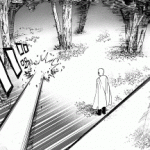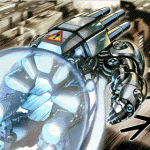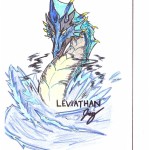FINALLY. MANGA. WE GET TO REVIEW MANGA. At this point, just having the oppotunity to have manga acknowledged or at the very least analyzed in ArtsOne is fantastic. (Good choice of manga, Jason *thumbs up* !!) However, this is both advantageous and troubling to some extent. Advantageous because this is the field of art and story-telling that I’ve dedicated most of my life to (hobby-wise and potential career-wise), so I’ve researched my fair share on the matter. On the other hand, it’s just as troubling to talk about because manga/comics are, like any medium of art, flexible in its form. There are so many factors to consider: the history, the style, the editing processess, the aesthetic, etc. Where do I even start? … I suppose the best thing for me to discuss here are some examples that have influenced me as an artist and the essential processes of manga. Let’s see where this goes …
Influences
Osamu Tezuka (手塚治虫) is no doubt the “God of Manga” and “Godfather of Anime”. As a young child, however, my influences were Rumiko Takahashi (高橋留美子) and Tite Kubo (久保 帯人). Rumiko Takahashi is one of the most influential mangakas (manga artist) of Japan where she is acknowledged as one of the best selling female comic artists globally and rumored to be one of the wealthiest women in Japan; since the 1980s, Rumiko’s manga has and is still distributed worldwide in a variety of languages. Some of her most famous works at the time include Urusei Yatsura, Maison Ikkoku, and Mermaid Saga. Rumiko’s works often range from comedy, Japanese folklore, action, horror, and romance. Near the early 90s, Ranma 1/2 and Inuyasha were two large and popular series that divide her styles more definitely: both manga are influenced by Japanese folklore/fantasy where Ranma 1/2 is a romance-comedy and Inuyasha is more akin to the horror/dark genre of storytelling.
Similarly, Tite Kubo’s serialized works such as Bleach, focus on action genres put in a modern setting. At the same time, he influences the story with Japanese folklore (死神 – Shinigami/Death Gods). There’s no doubt that folklore in the Japanese culture is extremely important, but only a few great artists are able to produce successful manga such as Tite Kubo and Rumiko Takahashi. Mainstream/overrated manga or not, you have to give credit to these artists. Why? Because at the end of the day, the manga industry idealizes a great story over great art. If you’re able to do both … perfect.
Working Out the Kinks
Most mangaka start off by becoming a mangaka’s assistant, completing tasks like inking, photocopying, etc. Another common method is to create a single piece of manga (called a “oneshot”) consisting of an average of 30-40 pages. From there, one will either contact a manga agency for review of the work and potential serialization or enter in contests where the same thing happens afterword.
“Oh! It’s only 30-40 pages! How hard could it be!?”, said a fool in the distance.
It’s stressful making a manga, much less anything satisfactory as an artist. Because the manga industry is extremely competitive, creating a good storyline/artwork may not be enough to get acknowledged. This makes the entire process of starting the piece is difficult (I’ll touch on this in a moment). But, BUT! As corny as it sounds, being passionate about making manga is absolutely essential. If you do manage to overcome the stress, get approved by an editor, and meet your deadlines on time, then congratulations! You’re practically on your way to becoming a true mangaka. Then again, sure, you’ve made it to the biz, but you have an even rougher road to go.
For most manga publications, the serialization process for each chapter is condensed to a week. This eliminates any slackers wishing to create manga, as no mangaka is ever in charge of when they want the artwork to be finished. The tight deadline forces one to get the work done or risk being fired; the mangakas finishes their share of the work and the publication team ensures that art get distributed in a timely fashion.
Before the production of the next chapter, a storyboard must be drafted (with panels/potential dialogue) and presented to the editor. The editor is essentially, your boss who will recommend any last minute changes to improve the series. Sounds pretty standard here, but the real catch is if your storyboard isn’t up to the editor’s standards, is lacking some oomph, or isn’t well developed enough, where the editor will then need you to change some or the entire draft you’ve just made. This means, those 30 pages of potential reading material just went down the gutter and you must learn to be flexible with your work to accommodate for these instances. The good news is that this step is the most difficult and the rest are pretty smooth-sailing. For the next few days, a mangaka will draft the images onto manuscript paper.
- Day 1: Roughly sketch the basic shapes/position of the characters + general backgrounds
- Day 2: Line art + Define features (hair, eyes, fingers, etc)
- Day 3: Shading + Screen tone, Lines, Sound effects
- Day 4: Speech Bubbles
- Day 5: Inking
- Day 6: Any final fixes + production crew takes over
- Day 7: Plan for the next chapter
- (Repeat)
(A general order of the process of manga)
The Good News
These days, becoming a self-sufficient manga artist is easier. There are an abundance of social media (Smack Jeeves, DeviantArt, Tumblr, etc) that allow artists to showcase their work online and computer programs such as Sai, Photoshop, Manga Studio that take away the stress of traditional manga making (panels, inking, etc, by hand). For a more time-constrained artist, this option is the most favorable, however, the popularity of the work may not be as successful as entering the manga industry with a company. Online self-publications usually risk the threat of art theft/plagiarism and credibility. Despite this, the majority of social media sites have adequate protection against these factors. Another benefit is the ability to maintain contact with the audience through commissions and fan mail; additional income if the artist creates merchandise. We cannot forget, of course, the joys of working as a free-lance artist.
Panelling Magic
Let’s end this ramble off with amazing works of panelling.
The best panelling I’ve ever seen?
That would have to be Yusuke Murata’s (村田 雄介) One Punch Man in back to back pages.

Fan-made OPM gif 1

Fan-made OPM gif 2 (color)
(Click to see the gifs!)
Look at it in its glory. Need I say anymore?
It’s flawless.
If you’re interested in looking at more amazing (fan-made) gifs of Yusuke’s work , the site is provided at:
http://www.crunchyroll.com/anime-news/2013/03/06/chapter-of-one-punch-man-manga-turned-into-incredible-animated-gif




